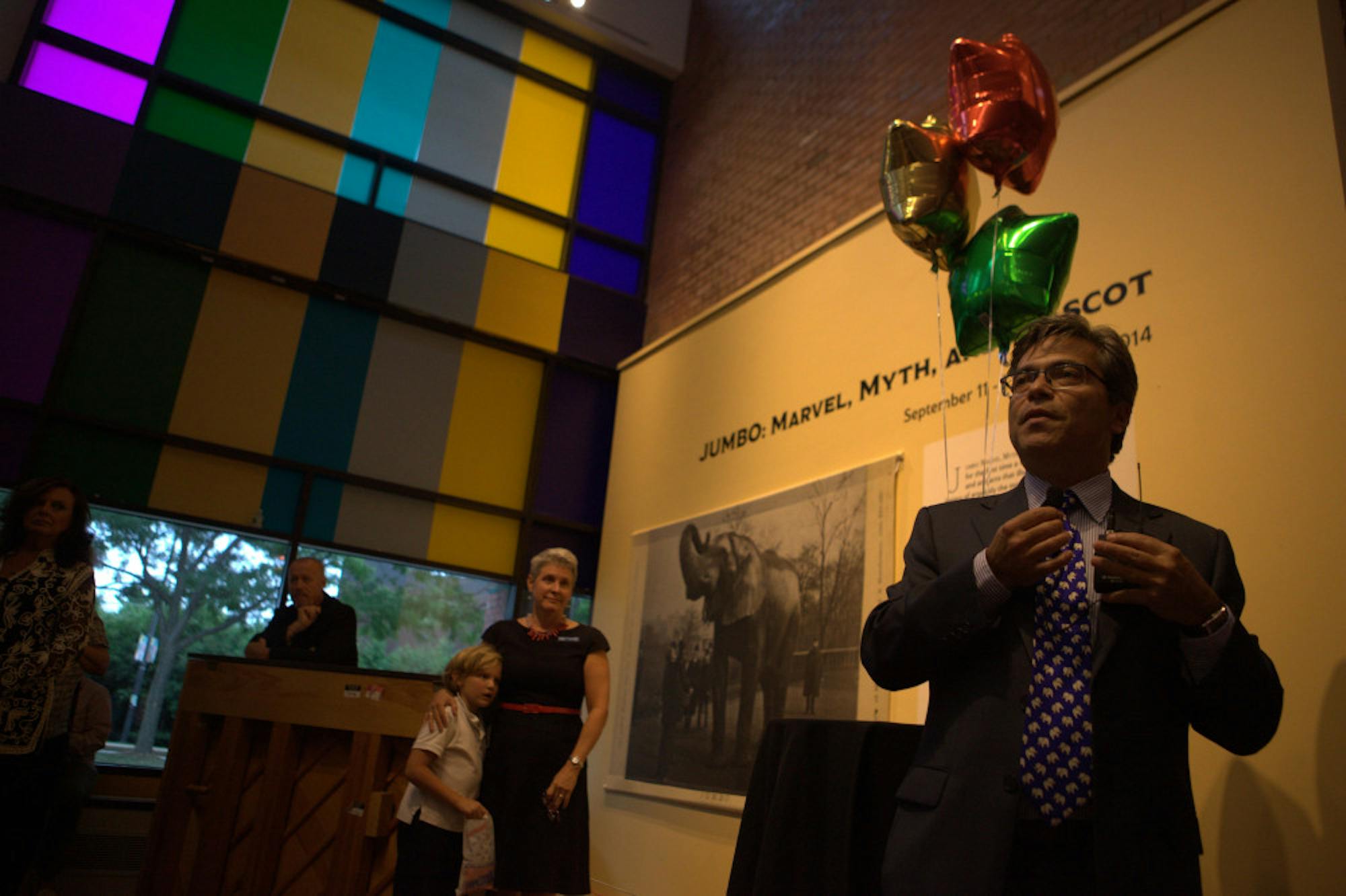The elephant, the mascot, the legend: Jumbo and his legacy are the focus of the Tufts Art Gallery's new exhibit “Jumbo: Marvel, Myth and Mascot." Curated by Tufts Professor of Art History Andrew McClellan, the exhibition is the first comprehensive exploration of Jumbo, who arrived on campus 125 years ago. The story encompasses Jumbo’s journey from Africa, his growing fan base at the London Zoo, his famous role in P.T. Barnum’s “The Greatest Show on Earth” and his unfortunate death in a train accident. However his legend doesn’t end there -- Jumbo is immortalized in popular culture and as Tufts’ adored mascot.
Posters, photographs, household items and even the ashes and taxidermic tail of Jumbo himself, convey the mystery and myth of Jumbo while also taking great care to tell the truth behind this legend. Despite the depiction of Jumbo as a larger-than life-creature of many talents, visitors will learn that some tales were designed for Barnum’s publicity.
Professor Andrew McClellan brings a unique background in the history of museums and collecting to the exhibition. At one time, Tufts had a distinguished museum of natural history endowed by founding trustee P.T. Barnum, the same trustee who donated Jumbo’s remains. When McClellan found out that the Jumbo statue was being replaced on campus (coming later this semester), he thought the moment was right to create both an exhibition and a book.
McClellan’s interest was academic but also personal.
“I’ve been at Tufts 28 years, and wanted to do something stimulating and meaningful for the Tufts community,” he told the Daily.
The exhibition is divided into two spaces. The first is an introductory area in the Harry Remis Sculpture Court with an overview of the exhibition and multimedia components. A looped video clip shows Jumbo’s legacy in theater and film, including "Jumbo" (1962), a film starring Jimmy Durante and Doris Day, and the famed Disney film “Dumbo” (1941). The second is another screen with a wonderful slideshow of photographs taken by and of Tufts students with their mascot. The photos convey the idea of Jumbo as a crucial part of our student body's school pride and community.
The primary component of the exhibition is in the Koppelman Family Gallery. This space operates like a storyline, with segments titled “Out of Africa,” “Jumbo Joins the Circus” and “Death and Afterlife.” Highlights of Jumbo’s life are illustrated through photographs and posters, as well as cases with unique memorabilia. From London there’s a handkerchief that tells the story of Jumbo leaving his “girlfriend” and fellow elephant at the London Zoo, as well as an autobiography of Jumbo’s keeper and Jumbo’s Biography (1885). Other captivating items include a 3D- printed replica of Jumbo’s tusk and the circus route map of Barnum and Bailey’s “Greatest Show on Earth” during Jumbo’s last season (1880).
But how does one organize such disparate item, ranging from Jumbo's ashes to circus popcorn bags, into a cohesive narrative? According to McClellan, “mounting an exhibition [was] a collaborative process,” in which he worked closely with Gallery staff. The result is a thoughtful exhibition that’s informative and interactive: glass cases invite viewers to contemplate objects from multiple perspectives, available handouts elaborate on case contents and the colorful exhibition book is available for curious visitors.
What makes this exhibition so lively is its use of atypical objects to tell Jumbo’s story. Although visitors might not usually expect to find these trinkets in an art gallery, they provide an intimate portrait of Jumbo, effectively capturing the mania surrounding him. Perhaps the most surprising items on display are odds and ends found in Jumbo’s stomach after he died, some of which include a button, a tooth and a miniature toy gun.
This exhibition marks the 125th anniversary of Jumbo at Tufts, but McClellan sees the opportunity as even more than that.
“No other university could stage an exhibition like this, because they have as their mascot a generic bobcat or wolverine that has no substance or history behind the image," he said. "You can’t do much of an exhibition about an empty symbol. We at Tufts have as our mascot a historic creature, and not just any creature but arguably the most famous animal that ever lived.”
McClellan also feels that there’s another important story at work here, which is the history of interaction between humans and animals. He mentioned, “Not least, it can prompt us to become more aware of the senseless slaughter of elephants on the African continent for their ivory and do our bit to stop it.”
"Jumbo: Marvel, Myth and Mascot" is on display through Dec. 7, 2014 at the Tufts University Art Gallery in the Shirley and Alex Aidekman Arts Center. The Tufts University Art Gallery is fully accessible and admission is free.
Jumbo exhibition celebrates beloved mascot's unique history

Dr. Andrew McClellan introduces his exhibit "Jumbo: Marvel, Myth and Mascot" at the Tufts Art Gallery.





